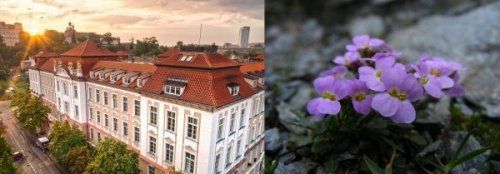
The Functional and Evolutionary Genomics group (me!) at Nord is recruiting a PhD student on an exciting project on dwarf Atlantic salmon - please share widely!
Applications and more information:
www.jobbnorge.no/en/available...
@thamala.bsky.social
Evolutionary biologist studying plant genomics and crop improvement. Senior scientist at Natural Resources Institute Finland (Luke). https://thamala.github.io

The Functional and Evolutionary Genomics group (me!) at Nord is recruiting a PhD student on an exciting project on dwarf Atlantic salmon - please share widely!
Applications and more information:
www.jobbnorge.no/en/available...

Our paper looking at the impact of whole-genome duplications (or polyploidy) on the evolution of genomic structural variants is now published! With @leviyant.bsky.social and others.
26.06.2024 11:56 — 👍 4 🔁 1 💬 0 📌 2
Comparative genomics plot of sugarcane
Our groups' goal is to produce genomes that are useful; this does not always mean 'telomere-to-telomere' assemblies. The hybrid sugarcane genome is a nice example of this. The article is out this week in Nature: www.nature.com/articles/s41...
29.03.2024 17:14 — 👍 26 🔁 11 💬 1 📌 0
A screenshot of two pages from a book including an illustration of an alpine floodplain landscape (cross section) with a stream and surrounding vegetation. The second page includes four large close-up photos of sedges and flowering plants

A screenshot of two pages from a book including an illustration of a lake shore cross section with different vegetation zones

A screenshot of two pages from a book including a two-panel illustration of an agricultural landscape cross section with a stream and zones with different land use designations

A screenshot of two pages from a book including an illustration of a riverbank cross section with different vegetation zones
I can now share some of the illustrations I’ve been working on last summer. These are from an upcoming book about the links between aquatic and terrestrial biodiversity. Thanks @florianaltermatt.bsky.social for the opportunity to design the figures. The book link: www.haupt.ch/buecher/natu... 🧪🐡
06.02.2024 18:46 — 👍 23 🔁 4 💬 0 📌 0PhD opportunity in my group at UiO on adaptation to shifting temperatures in house sparrows. Looking for candidates interested in combining evolutionary genomics and ecological approaches! Please share! www.jobbnorge.no/en/available...
30.01.2024 18:20 — 👍 10 🔁 18 💬 0 📌 0Thanks Alina. Yes, I’m based in Jokioinen.
04.01.2024 16:08 — 👍 1 🔁 0 💬 0 📌 0Kiitoksia
04.01.2024 15:16 — 👍 0 🔁 0 💬 0 📌 0After spending a few years in the US and UK, I’m glad to be back home 🇫🇮
04.01.2024 14:23 — 👍 0 🔁 0 💬 0 📌 0Happy to say that I have started a permanent research job at the Natural Resources Institute Finland! I will continue studying plant genetics and genomics, but now directly in crops.
04.01.2024 14:22 — 👍 6 🔁 0 💬 3 📌 0
Just in time for the holidays, Jeff Groh cracks the story of an ancient, balanced polymorphism for heterodichogamy (male vs female flower order) in walnuts & pecans
www.biorxiv.org/content/10.1...

A large effect fitness trade-off across environments is explained by a single mutation affecting cold acclimation
www.biorxiv.org/content/10.1...


Current starting point for postdoc salaries at Oxford University is just over £36k - £2.7K under threshold. According to The Royal Society 62% of postdocs are non-UK nationals (5/6 in my lab). Two things: (i) postdocs are underpaid; (ii) UK science is screwed
royalsociety.org/-/media/poli...
The origins of maize were the subject of controversy for well over a century. Even in the 1950's botanists like Edgar Anderson weren't totally sure what continent it came from!
We published today a new model for maize origins (www.science.org/doi/10.1126/...). Let me tell you how we got here. 1/
New preprint out on the genetic causes and genomic consequences of breakdown of distyly in Linum. We present a new high-quality genome of the homostylous self-compatible species L. trigynum and compare it to its close distylous relative L. tenue. www.biorxiv.org/content/10.1...
18.11.2023 11:08 — 👍 4 🔁 1 💬 1 📌 1As jobs are coming out and folks are applying, here's your regular reminder of lots of examples of successful job apps (mostly research academia but also industry, PUI, gov). And if you've gotten a job recently, please consider contributing! github.com/RILAB/statem...
14.11.2023 17:01 — 👍 94 🔁 85 💬 2 📌 2
How much homoeologous gene conversion actually happens in allopolyploids? See our new work using Gossypium led by Justin Conover (conjustover.bsky.social):
www.biorxiv.org/content/10.1...
First author Josh Schraiber posted this new preprint of ours on the other place, but he's not on here yet, so I guess it's up to me
www.biorxiv.org/content/10.1...
And here's Josh's thread: twitter.com/jgschraiber/...
Check out our new preprint on adaptation to whole-genome duplication. Great work by @sianbray.bsky.social and @leviyant.bsky.social
27.10.2023 14:34 — 👍 3 🔁 0 💬 0 📌 0So excited to announce our search for an Assistant Professor focused on understanding plant response to climate change! Come join us at UC Riverside aprecruit.ucr.edu/JPF01827
24.10.2023 17:10 — 👍 59 🔁 67 💬 0 📌 3
Super cool stuff: "The genetic consequences of range expansion and its influence on diploidization in polyploids"
22.10.2023 06:21 — 👍 9 🔁 3 💬 0 📌 0
An infographic illustrating the concept of genetic gain. Genetic gain is the change of the average phenotypic value between the parent and offspring populations due to selection. For a given trait (e.g. tree height), the frequency distribution has a peak around the mean and tails of extreme values. In the offspring generation, the distribution is shifted to desired direction as a response to selection. Genetic gain realised in forest reproductive materials is further modified by other factors such as pollen contamination in seed orchards.

A comic style illustration of 4 species of European owls (sizes not to scale). Top left: eagle owl (Bubo bubo); bottom left: tawny owl (Strix aluco); top right: barn owl (Tyto alba); bottom right: snowy owl (Bubo scandiacus)

The logo for Prof. Tanja Pyhäjärvi's research group. They are based at the University of Helsinki and study forest genomics and breeding. The logo includes a distribution of fitness effects (a graphic representation of the mutation effects on the organism), a pine cone to symbolize plant reproduction, letters of genetic code (ATCG), and 0/1 numbers to signify numerical methods.

An illustration of black alder (Alnus glutinosa) tree and branch fragment with male and female flowers
Hi BlueSky - I’m a biologist and scientific illustrator open to commissions of scientific figures, illustrations, infographics, etc.
I’ve designed infographics about forest tree breeding, love drawing plants and silly characters for fun,
and also made a logo for @pyhatanja.bsky.social
🧪🐡 #SciComm

Can any evolutionary biologist please explain this paper to me? www.nature.com/articles/s41...
07.10.2023 19:53 — 👍 49 🔁 13 💬 16 📌 5
We are hiring! TWO ERC and ERC-CZ postdoc positions in the population and structural genomics of polyploidy. Join us in stunning Prague to study the evolutionary consequences of whole genome duplication! Apply by 30 Oct. static1.squarespace.com/static/5e39c... and tinyurl.com/4e43wcy7
05.10.2023 18:03 — 👍 13 🔁 8 💬 1 📌 1
Our new paper is up on bioRxiv! We study how whole-genome duplications influence structural variant evolution in a natural diploid—autopolyploid system. With @leviyant.bsky.social and others.
Check it out if you like polyploidy, SVs, long-read sequencing, or pangenomes. #evobio